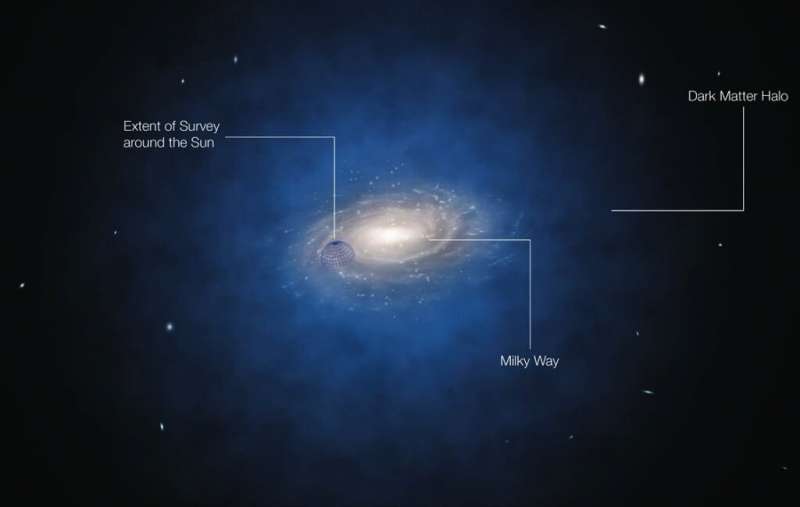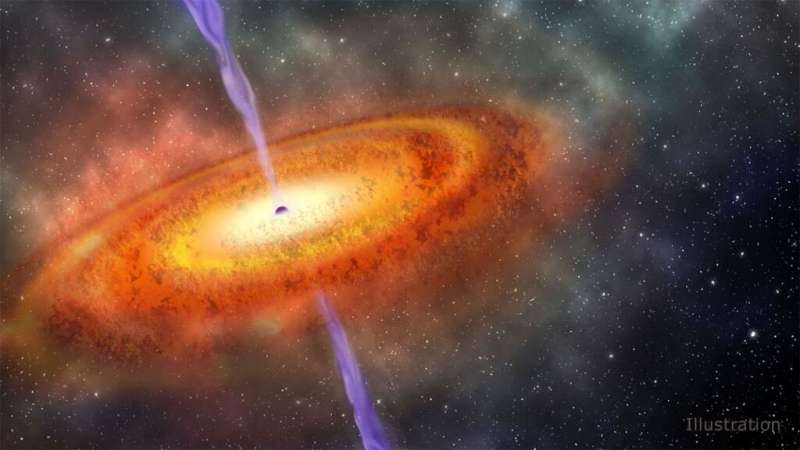Is dark matter made of axions? Black holes may reveal the answer

What is dark matter made of? It's one of the most perplexing questions of modern astronomy. We know that dark matter is out there, since we can see its obvious gravitational influence on everything from galaxies to the evolution of the entire universe, but we don't know what it is. Our best guess is that it's some sort of weird new particle that doesn't like to talk to normal matter very often (otherwise, we would have seen it by now). One possibility is that it's an exotic hypothetical kind of particle known as an axion, and a team of astronomers are using none other than black holes to try to get a glimpse into this strange new cosmic critter.
Axion Agenda
I'll be honest with you, we don't know if axions exist. They were invented to explain a conundrum in high-energy physics. There's a certain kind of symmetry in nature in which switching out the electric charges of all particles in a random interaction and running the process in the mirror produces the exact same result. This is known as charge and parity symmetry, or CP-symmetry for short.
This symmetry holds everywhere in nature, except when it doesn't, as in the case of the weak nuclear force, which is able to violate this symmetry whenever it feels like it.
The conundrum is that by all rights, the strong nuclear force should violate this, too. There are terms in the mathematics that very obviously break CP-symmetry, and yet we don't see any signs of symmetry breaking with the strong nuclear force in any of our experiments. So something must be going on to restore this symmetry when it ought to be broken.
The answer—or at least one potential answer—is a new kind of particle called the axion. The axion restores a certain kind of balance in the force (yes I'm aware of the Star Wars reference, here) so that CP-symmetry is preserved and everyone can go about their daily lives. Of course, experiments to date haven't directly revealed the existence of the axion, and there's a range of possible masses and properties that the axion could have.
Within that range of possible allowable masses and properties of the axion, something remarkable occurs. If we want to fill up the universe with dark matter, that dark matter has to have certain properties. It can't interact with normal matter very often and it can't even interact with itself very often, either. Also, there needs to be a lot of it, and it needs to be very stable and long-lived. It turns out that some of the range of possible axion properties make that hypothetical particle a candidate for dark matter.
The Dark Axions
If we consider the axion to be dark matter, it can generally explain all the usual dark matter observations. It can explain the rotation curves inside of galaxies. It can explain the motions of galaxies within galaxy clusters. It can be manufactured in sufficient abundance in the early universe to fit observations of the cosmic microwave background. And so on.
What's more, axions in the cores of galaxies can bundle together tightly enough to form a single massive ball that would at first blush look a lot like a supermassive black hole. It would be small, it wouldn't interact with light, and it would be incredibly massive. While recent observations from the Event Horizon Telescope gave us a literal picture of a giant black hole in another galaxy, it doesn't necessarily rule out that these axion cores still lurk in the depths of galaxies across the universe. And it's with these possible axion cores that we might be able to get a handle on their properties.

Black Holes are the Key
Aside from the Event Horizon Telescope, we have no direct observations of supermassive black holes. We can only see the material that is swirling and seething around them. And from the properties of that material, we can estimate the size and mass of the black holes. With these techniques, we've uncovered a very strange relationship over the decades: More massive galaxies host more massive black holes in their centers. This relationship is actually relatively tight, and it tells us that black holes somehow co-evolve with their host galaxies.
But like I said, we can't observe the black holes directly. So they might not be black holes at all. They might be axion cores hiding in the centers of those galaxies. If this is the case, then it's not that black holes co-evolved with their host galaxies, but that axion cores co-evolved with their host galaxies. The bigger the galaxy, the more axion dark matter it can host, and the bigger the axion core in the center.
This means we can use the relationship between the central dark object (whether it's a black hole or an axion core) and the galaxy itself to constrain the properties of axions. This works, because if you start playing with the axion particle mass, it affects how easily axions can clump up to form a core, which changes the relationship to the host galaxy.
A team of astronomers recently employed the relationship between black holes and galaxies to do exactly this, and were able to place some upper limits on the axion particle mass, which will help guide future experiments and direct searches. Is the axion responsible for the dark matter in the universe? Hopefully, we can shed some light on the situation someday.
More information: Vincent Desjacques, Adi Nusser. Axion core—halo mass and the black hole-halo mass relation: constraints on a few parsec scales: arXiv:1905.03450v1 [astro-ph.CO]
Source Universe Today





















